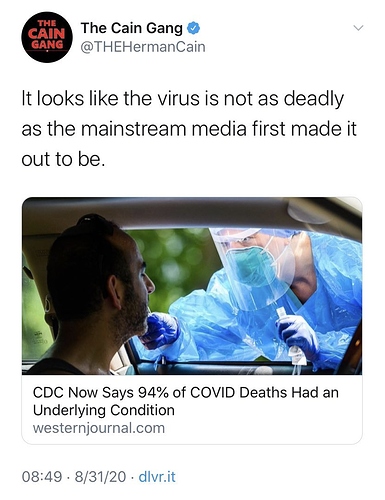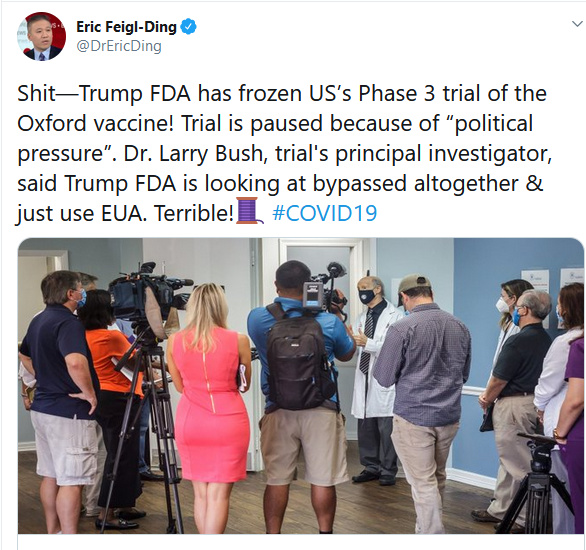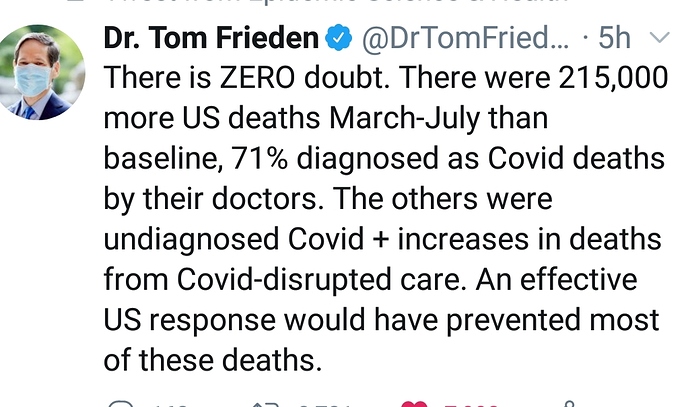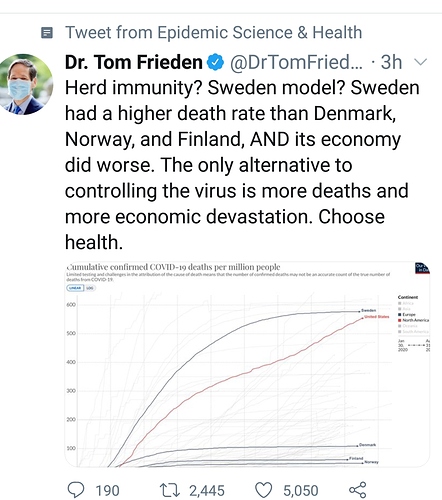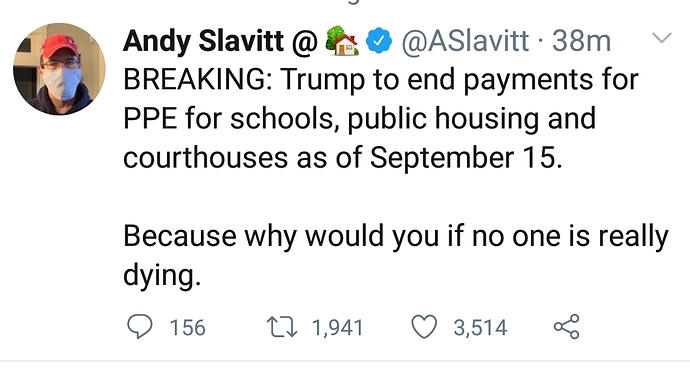A pandemic raging within your borders; 40,000+ cases and 1000 deaths a day and this!

No social distancing and I count 2 masks.
Insane.
Not to mention just about all of Louisiana right now. 
It begins.
This is something I’ve long been afraid of; most poll workers are older people, and even during the primaries, when we voted in our quiet little polling place, we noticed many familiar faces missing… and many who were there, older folks we worried for.
https://www.youtube.com/watch?v=30929_R5icI
Pernicious…
Coronavirus cases are surging again in Europe after months of relative calm, but the second wave looks different from the first: Fewer people are dying, and the newest and mostly younger victims of the pandemic need less medical treatment.
Unlike the initial hit of the pandemic this spring, which overwhelmed hospitals and turned nursing homes into grim mortuaries, the European resurgence of recent weeks has not forced as many people into medical wards.
But the increase is widespread, and it is unsettling societies that had hoped the worst was behind them. Paris on Friday joined some other French jurisdictions in imposing a citywide mask requirement, with cases spiking. France, Germany, Spain and others posted caseloads in recent days that had not been seen since April and early May. Spain has been hit particularly hard, with per capita cases now worse than in the United States — a notable marker in Europe, which after the initial springtime spike had generally controlled the virus more successfully than America.
The Secret Service is covering up coronavirus cases among its agents so as not to anger Trump.
Secret Service copes with coronavirus cases in aftermath of Trump appearances
Secret service agents are battling coronavirus cases as Trump campaign continues to host in-person gatherings: report
Secret Service grapples with coronavirus cases among agents traveling for Trump events: report
Look where we are…US 6 million cases…and the world has surpassed 25 million cases. 
Covid-19 Live Updates: U.S. Cases Pass 6 Million
Here’s what you need to know:
The jump in infections comes as the daily rate continues to decline. New Delhi is reopening its subway, even as India sets global records for new cases.
Right Now
The world has surpassed 25 million confirmed cases.
Now, those up on their Herman Cain trivia might get why this is a bizarre thing to open a browser tab to.
How a single rural wedding led to dozens of coronavirus cases and changed the contours of Maine’s coronavirus outbreak.
It has infected at least 123 people, caused secondary outbreaks at a Madison rehabilitation center in & the York County Jail in Alfred ( over 200 miles south), and 1 woman who did not attend the wedding has now died from the disease.
COVID vaccine trial in county paused due to ‘political pressure,’ doctor says
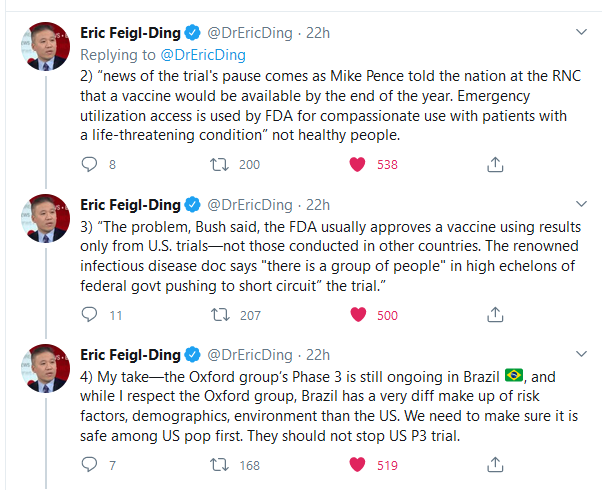
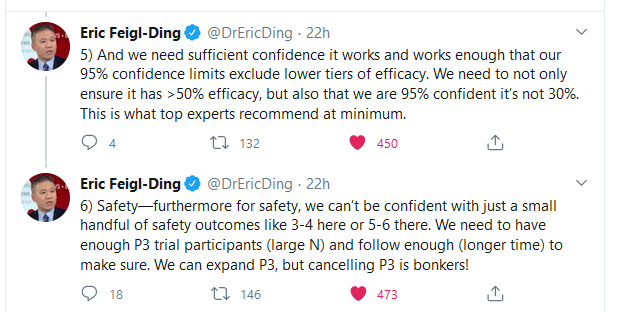
This is insane. If you actually want to get a vaccine out, you don’t suddenly STOP trials. I have a horrible feeling about this.
New Trump pandemic adviser pushes controversial ‘herd immunity’ strategy, worrying public health officials
One of President Trump’s top medical advisers is urging the White House to embrace a controversial “herd immunity” strategy to combat the pandemic, which would entail allowing the coronavirus to spread through most of the population to quickly build resistance to the virus, while taking steps to protect those in nursing homes and other vulnerable populations, according to five people familiar with the discussions.
The administration has already begun to implement some policies along these lines, according to current and former officials as well as experts, particularly with regard to testing.
The approach’s chief proponent is Scott Atlas, a neuroradiologist from Stanford’s conservative Hoover Institution, who joined the White House earlier this month as a pandemic adviser. He has advocated that the United States adopt the model Sweden has used to respond to the virus outbreak, according to these officials, which relies on lifting restrictions so the healthy can build up immunity to the disease rather than limiting social and business interactions to prevent the virus from spreading.
[…]
Atlas, who does not have a background in infectious diseases or epidemiology, has expanded his influence inside the White House by advocating policies that appeal to Trump’s desire to move past the pandemic and get the economy going, distressing health officials on the White House coronavirus task force and throughout the administration who worry that their advice is being followed less and less.
Atlas declined several interview requests in recent days. After the publication of this story, he released a statement through the White House: “There is no policy of the President or this administration of achieving herd immunity. There never has been any such policy recommended to the President or to anyone else from me.”
Let’s do the math, the US population is about 330M, the US mortality from COVID-19 is about 3.1%, herd immunity is reached when 60% of the population contract the virus. So ~198M would have to become ill. The US would reach herd immunity with a death count of 6.14M Americans.
Louder for the kids in the back,
The US would reach herd immunity with a death count of 6.14M Americans
Mask Up and Shut Up
COVID-19 transmission would go down if we spoke less, or less loudly, in public spaces. Why aren’t more people saying so?
“It is finally time to talk, in this pandemic, about the importance of not talking in this pandemic.”
Scott Atlas, by the way, is NOT an epidemiologist or anything else that would give him a credible voice on handling COVID-19 – he’s a neuroradiologist.
If his plan to “save” America involves sacrificing 6.2 MILLION citizens, he shouldn’t even be that.
People of color are disproportionately affected by covid-19. Yet they are underrepresented in vaccine trials.
Karen Bass, a Democrat, represents California’s 37th District in the House of Representatives and is chair of the Congressional Black Caucus.
Six months into our battle against covid-19, the disease has killed more than 181,000Americans, and the pandemic continues to disproportionately affect communities of color. Black Americans, Latinos, Asian Pacific Islanders and Native Americans are significantly more likely than White Americans to be diagnosed with covid-19, be hospitalized over it and die of the disease.
Despite these appalling trends, the most promising covid-19 vaccine trials are reportedly failing to recruit participants of color. This threatens the trials’ validity, since vaccine candidates can vary in effectiveness across different racial and ethnic groups. It is also potentially catastrophic for people of color, who are disproportionately representedamong front-line and essential workers — and who are suffering the worst health and economic effects of this pandemic.
Full coverage of the coronavirus pandemic
Facing criticism, pharmaceutical executives appear to be scrambling to assure the public that people of color will be well represented in vaccine trials. Too much is at stake to not get this right.
The National Institutes of Health and the companies working on stage-three vaccine trials must urgently recruit Black, Latino, Native American and Asian Pacific Islander participants, using strategies endorsed and supported by the communities they are targeting. Pharmaceutical companies must not be allowed to hide data by lumping racial and ethnic groups together: Disaggregated data on enrollments by age, gender, race and ethnicity should regularly be made available to Congress and the public before the trials begin. And vaccines should only be made available to the public if they have been proved effective for everyone, in trials that represent the true diversity of our nation.
Americans of color have reason to be wary of participating in medical research. For centuries, medical researchers and practitioners experimented on patients of color without their consent. The four-decade Tuskegee experiment misled poor Black men in Alabama into believing they were being treated for syphilis while researchers were merely keeping tabs on them until they died, so their bodies could be autopsied. Even after the discovery of penicillin, U.S. Public Health Service doctors and nurses administered only aspirin and placebos.
There are other, less infamous examples of racist medical experimentation. As many as 1 in 4 Native American women and girls were sterilized without their consent by the Indian Health Service in the 1960s and 1970s — going under the knife to have their tonsils removed and emerging without their reproductive organs. Unknown thousands of Black women and girls suffered involuntary hysterectomies during the 20th century, including civil rights icon Fannie Lou Hamer.
More recently, in my hometown of Los Angeles, researchers gave Black and Latino babies as much as 500 times the approved dosage of the experimental EZ measles vaccine between 1989 and 1991 — even though the vaccine had been linked to hundreds of deaths in developing countries. Parents were not told that the vaccine was experimental or that their children were intentionally being given overdoses.
The only way to overcome this history is for medical researchers to meaningfully involve communities of color at every stage of the process. Black Americans and Latinos are still significantly less likely than non-Hispanic Whites to be enrolled in clinical trials. Those running the covid-19 vaccine trials must break down the social and economic barriers that can keep people of color from taking part.
The NIH and pharmaceutical companies must partner with trusted community organizations; those messengers can take the lead on recruiting and enrolling more Black, Latino and Native American trial participants. Targeted outreach includes providing meaningful funding for the community organizations to hold information sessions and answer questions. Provisions to support and fund aggressive, targeted outreach and interventions for testing, treatment and any eventual vaccine for the communities of color suffering most from covid-19 were included in the Heroes Act that the House passed in May. The Senate has yet to take up the legislation.
Pharmaceutical companies and NIH can make it easier for people of color to enroll in vaccine trials by extending clinic hours to evenings and weekends, reimbursing or providing vouchers to help cover transportation costs, and providing consent forms and other enrollment materials in languages other than English. At every step, researchers must counteract our nation’s legacy of medical abuse by being utterly transparent: clearly communicating risks and making sure patients understand how the data collected is being used.
Until covid-19 is under control, lives will remain disrupted — with kids out of school, parents out of work, and thousands falling ill and dying. Since the Trump administration has failed to contain the spread of the coronavirus— and shows no interest in learning from its mistakes — the pressure is on to develop vaccines that are safe and effective for everyone. If vaccines are not effective for those most at risk from covid-19, we will have failed all over again.
There’s still a chance for the NIH and pharmaceutical companies to get it right. We are watching to make sure they do.
Steven Joffe: It’s time to start testing potential covid-19 vaccines on children
Michael Gerson: It puts everyone in danger if rich countries hoard a vaccine
FDA Commissioner Stephen Hahn: No matter what, only a safe, effective vaccine will get our approval
Madness; Senator Joni Ernst is pushing two #QAnonsense COVID conspiracies, one that the actual death rate is only 6% of what’s being reported, the other that doctors are falsely reporting cases because they get paid more for treating COVID patients.
Here is an excellent thread about this insanity:
Not in the name of health, but for T’s re-election to make it ‘look’ better.
Trump admin. considers enlisting celebs as part of $250M COVID-19 public health ad campaign - ABC News
The official, who spoke on condition of anonymity because the person was not authorized to speak publicly on the details, said the idea followed a private Zoom call Dr. Anthony Fauci had earlier this year with some 30 celebrities. The celebrities were allowed to ask Fauci anything they wanted on the call, which lasted more than an hour.
The call suggested to administration officials that the American people have the same questions the celebrities have, the official said, and the agency decided it might need an ad campaign to have public figures ask top Coronavirus Task Force doctors and scientists questions for a series of one-minute public health ads.
But critics questioned whether the public relations push was aimed at boosting President Trump’s reelection chances rather than informing the public on the health crisis six months after the first U.S. case was detected. Politico, which first reported on the potential $250 million proposal, obtained a letter from the administration to communications firms that stated the goal of the contract would be to "defeat despair and inspire hope” about the coronavirus pandemic.
House Majority Whip Jim Clyburn told reporters on Tuesday: "That sounds like another 250 million in taxpayer money to be used politically
Early in the pandemic I joked about the scene from Roxanne where Steve Martin’s character chastises the incompetent volunteer fire department, telling them that it would be a bad thing if people said “whatever you do, don’t call the fire department.” Well, here we are.
It Has Come to This: Ignore the C.D.C.
The agency’s new guidelines are wrong, so states have to step up on their own to suppress the coronavirus.
Harold Varmus is a former director of the National Institutes of Health. Rajiv Shah is the president of the Rockefeller Foundation.
We were startled and dismayed last week to learn that the Centers for Disease Control and Prevention, in a perplexing series of statements, had altered its testing guidelines to reduce the testing of asymptomatic people for the coronavirus.
These changes by the C.D.C. will undermine efforts to end the pandemic, slow the return to normal economic, educational and social activities, and increase the loss of lives.
Like other scientists and public health experts, we have argued that more asymptomatic people, not fewer, need to be tested to bring the pandemic under control. Now, in the face of a dysfunctional C.D.C., it’s up to states, other institutions and individuals to act.
Understanding what needs to be done requires understanding the different purposes of testing. Much of the current testing is diagnostic. People should get tested if they have symptoms — respiratory distress, loss of smell, fever. There is no argument about this testing, and the altered C.D.C. guidelines do not affect it.
But under its revised guidelines, the C.D.C. seeks to dissuade people who are asymptomatic from being tested. Yet this group poses both the greatest threat to pandemic control and the greatest opportunity to bring the pandemic to an end. It is with this group that our country has failed most miserably.
Consider the logic. Without tests or a highly effective vaccine, the only certain way to prevent further spread of the virus would be to isolate everyone from everyone else. In theory, this would work, but it is untenable — if not impossible — because of the economic and social consequences of shutdowns.
Tests, however, can reduce the number of people who need to be isolated — and only for as long as they are shown to be infected. If those tests were to be performed frequently (even daily) and widely (even universally), it is almost certain that the pandemic would evaporate in just a few weeks.
That much diagnostic testing is not feasible, given the costs and logistics, as well as the likelihood that some would refuse to comply.
So it makes sense to modulate the strategy by testing those who are at greatest risk of infection, and those who are most likely to spread the virus if they become infected.
We can make well-informed predictions about those who should be given priority. Most obviously, testing is essential for those who are known to have been significantly exposed to an infected person, as determined by “contact tracing.” But testing is also important for those who have been or will soon be mixing with large groups in close quarters at work; entering the schools and colleges that are now reopening; and attending public events like concerts and sports matches.
The financial and other practical demands of widespread testing can be lowered by making rational decisions about the optimal times for performing the tests — a few days after being in contact with an infected person, for instance, or just before congregating with many others.
The logistics and costs can be further reduced by simplifying the tests — using saliva samples collected at home, rather than uncomfortable nasal swabs that require trained personnel at specific locations; or by using so-called antigen tests, a cheap and rapid method to look for viral proteins, rather than expensive laboratory machines to find viral RNA. Even if these tests are a bit less accurate, their lower cost, higher speed and more frequent use make up for it.
Some of these new methods have already been authorized for use by the Food and Drug Administration. And the Department of Health and Human Services has also committed to purchasing large quantities of antigen tests.
These are practical and essential actions that need to be taken now. In the absence of sensible guidance from the C.D.C., what can the country do to control the pandemic? We urge at least three actions.
- State and local leaders should be emboldened to act independently of the federal government and do more testing. Some governors and local public health officials, from both parties, are already doing so and are ignoring the C.D.C.’s revisions. This position is legally sound, since the C.D.C. is an advisory agency, not a regulatory one. Still, such discord undermines confidence in public health directives.
- Insurance companies, city and state governments, and the Center for Medicare and Medicaid Services should recognize the economic and health benefits of testing prioritized, asymptomatic populations and provide reasonable reimbursement for these tests. A major impediment to more widespread testing has been the lack of coverage in the absence of symptoms or known contacts with infected individuals. The costs of testing are decreasing as new methods, like antigen testing, are introduced, and may be further reduced as the pooling of samples makes testing more efficient.
- While more widespread testing for the virus is an essential factor in pandemic control, we need to make it part of a broad program that helps prevent transmission — mask-wearing, hand-washing, quarantining and use of personal protective equipment.
The C.D.C., the federal agency that should be crushing the pandemic, is promoting policies that prolong it. That means that local, state and organizational leaders will have to do what the federal government won’t.
